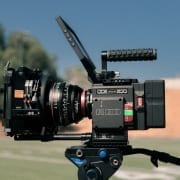The Big Picture of Business – How to Maximize Trade Show Exposure
The number of companies participating in trade shows increases each year. While sales objectives are most common, trade shows may also be behavior, product, distribution or marketing oriented. Booth exhibitions at trade shows are viable and cost-effective sales tools to:
- Achieve new customers, in order to grow and increase profits.
- Introduce new products. Most of the visitors come to see what’s new.
- Target a select group of visitors.
- Allow your staff to interface with the public.
- Perform informal market research.
- Educate the public about what your company and your industry do.
- Enhance your company’s image.
- Assess competition and the overall business climate.
Trade shows generate sales leads at a lower cost per contact than a typical sales call. Research shows that industrial sales calls costing $252 to reach a prospect, with 4.6 follow-up calls necessary to book an order = $1,158. At a trade show, you might spend $133 to reach a prospect, with .8 follow-up calls necessary to book an order = $334.
Exhibits can be designed to appeal to all the senses: sight, sound, touch, smell and taste. Research shows that 75% of what show visitors recall after expos is what company representatives told them.
Exhibiting in business-to-business shows requires different skills and approaches. The objective should be qualifying prospects, rather than selling. One meets more business prospects in a faster period of time at a trade show. Today’s customers are becoming increasingly complex and more difficult to identify. They are knowledgeable, sophisticated and have increased expectations about what they want. Customers are now under more pressure to act immediately.
These pointers are offered to prospective exhibitors before the show:
- Determine your correct mission for participating.
- Evaluate each trade show for what it contributes to your sales objective.
- Determine who you want as key prospects.
- Delineate other categories of visitors, and develop a strategy for maximizing your time with key prospects.
- Develop action plans for accomplishing your goals and getting the right people to visit with your company at the show.
- Be sure that booth personnel understand what they are responsible for…and what they are selling. Untrained staff can lose qualified prospects and leads.
- Employ professional counsel to format your exhibit, thus maximizing your investment.
- Keep labor costs to a minimum.
- Be sure that every member of your company is aware of the exhibit. Encourage all to invite prospects and to attend themselves, even if not involved in exhibiting.
- Market your presence at the show in advance via mailings, distribution of VIP tickets and inclusion of your booth in advertising. Invite your current clients to visit your booth. Most attendees go to the shows in response to invitations to visit specific exhibitors. * Notify your trade media that you will participate. Engage public relations professionals to publicize your involvement.
- Work closely with the show’s management. They too are interested in the same audiences as you: attendees and the media. Invite the board of the sponsoring organization to visit your booth.
These pointers are offered in order to maximize the way in which you should exhibit the product-service:
- * Graphically describe and show what you do. Don’t expect the product to show itself. Don’t expect people to know about you already. This is a fresh opportunity for you to communicate.
- Keep your focus upon your products, rather than pretentious displays.
- Keep the booth simple, clean and organized.
- Give facts and simple explanations of your products. Since many visitors may be unfamiliar, don’t assume that they know what you do.
- Ask questions and listen. Don’t concentrate on giving a sales pitch.
- Good lighting, decoration and booth dress are always relevant to the product.
- Show a maximum number of products.
- A good demonstration convinces visitors that your product is all you claim it is.
- Show what the product can do for them and what it has done for others.
- Give samples, if possible.
- Encourage audience participation.
- Distribute professionally-produced, factual literature, or don’t give out any literature.
- Use video as interactive demonstration elements, augmented by signage.
- Collect business cards, as the basis for follow-up activities.
- Make appointments to have in-depth presentations to serious prospects.
- Trade show selling requires high energy levels. Booth people must be pro-active, greet all prospects and learn how to qualify.
- Approach large numbers of people within short periods of time, determining how to best process each contact.
Research shows that trade show booths that have dishes of candy tend to draw twice the number of visitors than those without candy.
The value of premium giveaways lies in lasting impressions, increased name identification and paves the way for faster follow-ups with prospects.
These observations and recommendations are made for booth exhibit personnel:
- Booth personnel must be equipped to give precise, detailed information on your product.
- Train booth attendants for show duty. If possible, stage a dress rehearsal. Follow procedures for literature distribution, trash cleanup, conversation and public demeanor.
- Work out approach statements in advance. Have talking points in writing. Follow a step-by-step process.
- Staff with a technical representative, as well as a greeter. You can never have enough well-trained people at the show.
- Avoid the high-pressure approach.
- Do not smoke, drink or eat in the booth.
- Booth personnel should look and act the part. Stand up straight. Keep your hands out of your pockets. Use approachable body language. Do not sit down unless you are with a client.
- Dress conservatively.
- Keep small talk with other booth personnel to a minimum.
- Arrange and follow duty schedules. Keep staff alert and on their toes.
- Make booth visitors feel welcome at all times.
Lead collection and follow-ups must be treated seriously. After the show is over, don’t forget to follow through on details, promises and intentions:
- Send follow-up letters to each visitor who left a business card.
- Send out requested additional materials within one week after the show.
- Set a lead follow-up program, since early response is vital. Follow up on sales leads for at least two years after the show.
- Evaluate your results.
Your company’s commitment to participate in trade shows represents a big step. You should always want to improve the exhibit each time, thus insuring a return on the investment. The process of strategizing your exhibit relates directly to your company’s promotional and business development philosophy. This process inevitably makes every company’s marketing position much stronger.
About the Author

Hank’s latest book functions as a ‘PDR of business,’ a view of Big Picture strategies, methodologies and recommendations. This is a creative way of re-treading old knowledge to enable executives to master change rather than feel as they’re victims of it.
Power Stars to Light the Business Flame is now out in all three e-book formats: iTunes, Kindle, and Nook.









Leave a Reply
Want to join the discussion?Feel free to contribute!